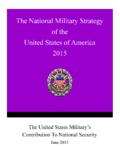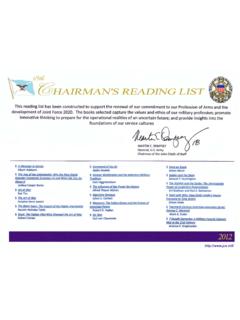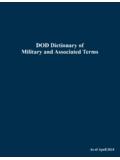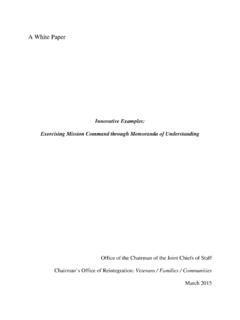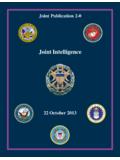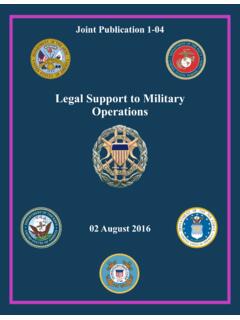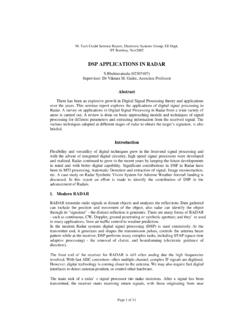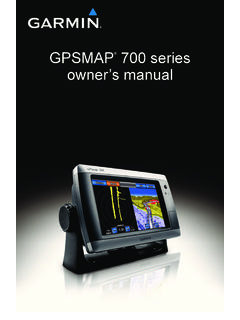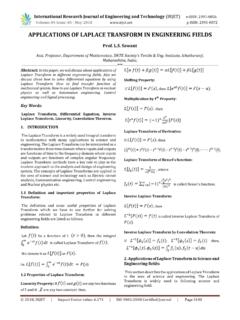Transcription of JP 2-03, Geospatial Intelligence in Joint Operations
1 DEPAOTMENTFTHEARMY EUNITEDSTATSOAFAMERICRTHISWE'LLDEFENDJ oint Publication 2-03 Geospatial Intelligence inJoint Operations5 July 2017 i PREFACE 1. Scope This publication provides doctrine for conducting Geospatial Intelligence (GEOINT) across the range of military Operations . It describes GEOINT organizations, roles, responsibilities, and operational processes that support the planning and execution of Joint Operations . 2. Purpose This publication has been prepared under the direction of the Chairman of the Joint Chiefs of Staff (CJCS). It sets forth Joint doctrine to govern the activities and performance of the Armed Forces of the United States in Joint Operations , and it provides considerations for military interaction with governmental and nongovernmental agencies, multinational forces, and other interorganizational partners.
2 It provides military guidance for the exercise of authority by combatant commanders and other Joint force commanders (JFCs) and prescribes Joint doctrine for Operations and training. It provides military guidance for use by the Armed Forces in preparing and executing their plans and orders. It is not the intent of this publication to restrict the authority of the JFC from organizing the force and executing the mission in a manner the JFC deems most appropriate to ensure unity of effort in the accomplishment of objectives. 3. Application a. Joint doctrine established in this publication applies to the Joint Staff, commanders of combatant commands, subordinate unified commands, Joint task forces, subordinate components of these commands, the Services, and combat support agencies.
3 B. The guidance in this publication is authoritative; as such, this doctrine will be followed except when, in the judgment of the commander, exceptional circumstances dictate otherwise. If conflicts arise between the contents of this publication and the contents of Service publications, this publication will take precedence unless the CJCS, normally in coordination with the other members of the Joint Chiefs of Staff, has provided more current and specific guidance. Commanders of forces operating as part of a multinational (alliance or coalition) military command should follow multinational doctrine and procedures ratified by the US. For doctrine and procedures not ratified by the US, commanders should evaluate and follow the multinational command s doctrine and procedures, where applicable and consistent with US law, regulations, and doctrine.
4 Preface ii JP 2-03 4. Contribution The following staff, in conjunction with the Joint Doctrine Development Community, made a valuable contribution to the revision of this Joint Publication: Lead Agent and Joint Staff Doctrine Sponsor Mr. Sean Murphy, Joint Staff J-2; Joint Analysis Division Action Officer Mr. Mark Brown, Joint Staff J-7, Joint Doctrine Analysis Division; and Joint Doctrine Action Officer LTC Gregory Browder, Joint Staff J-7, Joint Doctrine Division. For the Chairman of the Joint Chiefs of Staff: KEVIN D. SCOTT Vice Admiral, USN Director, Joint Force Development iii SUMMARY OF CHANGES REVISION OF Joint PUBLICATION 2-03 DATED 31 OCTOBER 2012 Clarifies the national security mission of National Geospatial - Intelligence Agency to include responsibility for analysis, dissemination, and incorporation of Geospatial Intelligence (GEOINT) produced by ground-based platforms or handheld photography into the national system for Geospatial Intelligence .
5 Expands Chapter II, Roles and Responsibilities, to include the contents of Appendix F, Geospatial Intelligence Roles and Responsibilities and Specific Guidance. Provides guidance on the establishment and composition of a notional GEOINT cell. Updates GEOINT activities conducted by national and Department of Defense-level agencies, the Services, and partner nations. Provides a more detailed description of GEOINT Operations activities and how GEOINT contributes to mission planning. Describes new processes and methods to organize and analyze GEOINT data, to include structured observation management, object based production, and activity based Intelligence .
6 Updates the various dissemination methods for data derived from national, commercial, airborne, handheld, and surface-based collection systems. Deletes Appendix C, Sample Annex M ( Geospatial Information and Services), in accordance with CJCSM , Adaptive Planning and Execution (APEX), 31 August 2012, which eliminates Annex M, Geospatial Information and Services, by consolidating it into Appendix C, Sample Appendix 7 ( Geospatial Intelligence ) to Annex B ( Intelligence ). Replaces Appendix D, Sample Appendix 7 (Imagery Intelligence ) to Annex B ( Intelligence ), with Sample Appendix 7 ( Geospatial Intelligence ) to Annex B ( Intelligence ), and merges in unique considerations for Geospatial information and services to reconcile the deletion of Annex M, Geospatial Information and Services.
7 Updates the list of organizations that provide meteorological and oceanographic support to GEOINT and removes links to Websites. Introduces concepts of human geography and data layer themes used within Geospatial Intelligence preparation of the environment. Updates the list of standard GEOINT products and services. Summary of Changes iv JP 2-03 Intentionally Blank v TABLE OF CONTENTS EXECUTIVE SUMMARY.
8 Vii CHAPTER I OVERVIEW OF Geospatial Intelligence Introduction .. I-1 Geospatial Intelligence Overview .. I-2 Geospatial Intelligence Support to Joint Operations .. I-4 CHAPTER II ROLES AND RESPONSIBILITIES National and Department of Defense-Level Entities ..II-1 Joint Staff ..II-7 Combatant Commands ..II-7 Subordinate Joint Force Commander ..II-9 Services ..II-10 Non-Department of Defense Agencies ..II-14 Commonwealth Allies ..II-16 CHAPTER III Geospatial Intelligence IN Joint Operations Joint Intelligence Operations Center .. III-1 Joint Geospatial Intelligence Cell .. III-1 National Geospatial - Intelligence Agency Intelligence Collaboration and Assistance III-4 Joint Intelligence Preparation of the Operational Environment.
9 III-5 CHAPTER IV Geospatial Intelligence ACTIVITIES Introduction .. IV-1 Direction, Planning, and Requirements Management .. IV-2 Discover and Obtain Geospatial Intelligence .. IV-4 Tasking and Collection .. IV-5 Processing and Exploitation .. IV-6 Analysis, Production, and Visualization .. IV-8 Dissemination, Collaboration, and Storage .. IV-12 Evaluation and Feedback .. IV-14 APPENDIX A Geospatial Intelligence and Joint Planning .. A-1 B Sample Geospatial Intelligence Estimate ..B-1 Table of Contents vi JP 2-03 C Sample Appendix 7 ( Geospatial Intelligence ) to Annex B ( Intelligence ).
10 C-1 D Geodetic Datums and Coordinate Reference Systems .. D-1 E Meteorological and Oceanographic Support to Geospatial Intelligence .. E-1 F Geospatial Intelligence Requirements Considerations .. F-1 G Geospatial Intelligence Products and Services .. G-1 H References .. H-1 J Administrative Instructions .. J-1 GLOSSARY Part I Abbreviations, Acronyms, and Initialisms .. GL-1 Part II Terms and Definitions .. GL-5 FIGURE I-1 Geospatial Intelligence in Joint Operations .. I-3 II-1 National System for Geospatial Intelligence ..II-1 II-2 Supply Chain Partners ..II-6 III-1 Notional Geospatial Intelligence Cell Organizational Construct.

